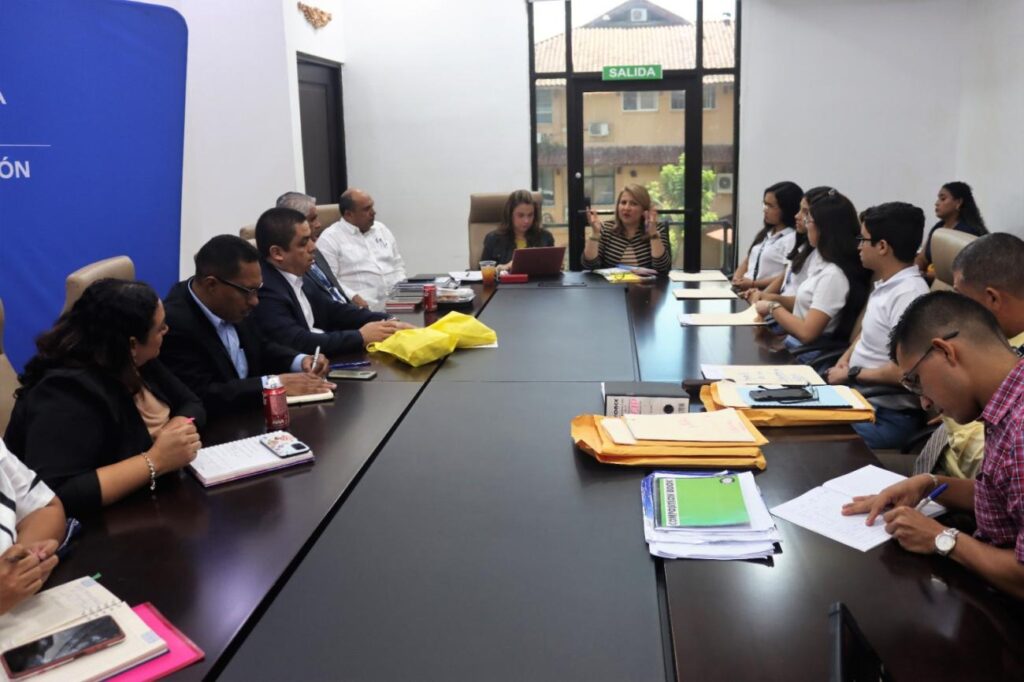La comunidad educativa del Centro de Formación Integral Bilingüe Papa Francisco, ubicado en la provincia de Herrera, se reunió con la ministra de Educación Maruja Gorday de Villalobos y su equipo de trabajo para atender algunas peticiones como mejoras en el sistema de aire acondicionado (A/A), laboratorios de ciencias e informática.
Por parte del Viceministerio de Infraestructura, este miércoles 30 de agosto, un equipo técnico hará la revisión de todos los A/A, el voltaje e identificar el problema y, a partir del diagnóstico, tomar las decisiones correctas para dar respuestas, según lo dio a conocer Carlos Zarzavilla, director Regional de Educación de Herrera.
Añadió que, en cuanto a los laboratorios de ciencias para la educación media, se notificó que se está en la etapa final de la gestión de compra y que, para inicios del tercer trimestre, podrían estar en el sitio, al considerar la gestión en que se encuentra con una logística de distribución y capacitación a los docentes para el uso de estos.
Para el laboratorio de informática se notificó que se tienen 50 computadoras, que se mantienen en la Dirección de Informática del Ministerio de Educación, en estos momentos se les instalan los softwares que requieren para hacer la entrega al colegio, agregó Zarzavilla.
“La reunión con la ministra ha sido positiva, se han dado respuestas a las soluciones para el plantel educativo y, gracias a la lucha liderada por los estudiantes, se han logrado cosas positivas y salimos de aquí confiados que esas promesas se van a cumplir y que nuestros alumnos van a tener una educación de calidad”, manifestó Carlos Tejada, presidente de la Asociacion de Padres de Familia del plantel educativo.
Los estudiantes y padres de familia, recibieron además, una inducción sobre el uso y manejo de la plataforma Ester.
Mabet Guerra, estudiante, dijo que “la plataforma Ester, es llamativa y productiva, pues muchos no prestamos la atención adecuada en el salón de clases, pero la herramienta está muy equipada y tiene mucha información y nos ilustra bastante”.
“La plataforma me pareció una forma entretenida y divertida de aprender porque se puede interactuar. Hay guías, exámenes interactivos, biblioteca virtual, simuladores virtuales, hay bastantes maneras de aprender con esta herramienta tecnológica”, dijo Cristhian Ruiz, también estudiante.
Además de la ministra de Educación y Zarzavilla, estuvieron presentes el viceministro de Infraestructura, Ricardo Sánchez; el director General de Educación, Guillermo Alegría; Erick Fruto, comisionado del Servicio Nacional Aeronaval; Inés Samudio, directora de Unidad Coordinadora de Infraestructura Pública.

Dirección: Calle Ernesto Jaén Guardia En Corozal, Corregimiento De Ancón, Ciudad De Panamá. Central Telefónica: 515-7300 / 511-4400
© 2025 Todos los derechos reservados | Ministerio de Educación

